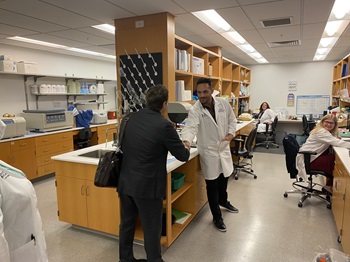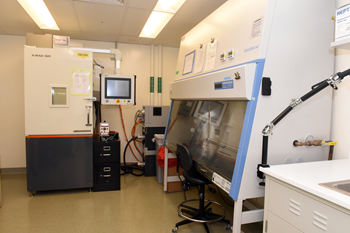 Complications associated with radiation therapy impart a significant toxicity burden on cancer patients often resulting in treatment interruptions, hospitalizations, and poor prognosis acutely and reduced quality of life chronically. As of January 20222, the cancer survivor population in the United States is estimated to be 18.1 million (a 31% increase from 2012) with the largest growth (28%) in cancer survivorship among individuals living fifteen years past diagnosis.
Complications associated with radiation therapy impart a significant toxicity burden on cancer patients often resulting in treatment interruptions, hospitalizations, and poor prognosis acutely and reduced quality of life chronically. As of January 20222, the cancer survivor population in the United States is estimated to be 18.1 million (a 31% increase from 2012) with the largest growth (28%) in cancer survivorship among individuals living fifteen years past diagnosis.
As a result, the economic burden imparted on cancer survivors is expected to be significant with a 27% increase in cancer care costs as a result of long-term follow-up and treatment-related complications. Currently, there is no approved treatment intervention to mitigate and/or treat the side effects of radiation cancer treatment, either acutely or chronically. The division is addressing this unmet need by expanding on the substantial scientific and financial investment from the U.S. government to move promising therapeutics towards clinical trials to mitigate and/or treat the side effects of radiation therapy.
Toxicities being addressed in pre-clinical models include (but are not limited to) erectile dysfunction following RT for prostate cancer, pneumonitis/lung fibrosis after thoracic radiotherapy for breast cancers, lung cancers, lymphomas, and thymomas, and neurocognitive decline associated with whole brain radiation. Thus, the division is making significant strides to reduce the psychological, social, and economic burden imparted on cancer survivors and the healthcare system in the 21st century.
Members

Erika W. Davies, PhD, MS (she/her)
Assistant Professor of Radiation Oncology
Director of Medical Countermeasure for DTRS
Research Highlights
Prostate-Confined Radiation Therapy to Interrogate the Biological Mechanisms Underlying Radiation-Induced Erectile Dysfunction

- First to develop a small animal model of erectile dysfunction induced by prostate-confined irradiation using a small-animal research radiation platform with cone-beam CT imaging to better mimic late normal tissue effects from radiation therapy (RT). Endpoints include bioassay for erectile function, intracavernous pressure measurements, histology, biomarker and molecular analysis.
- Research is focused on elucidating radiation effects on the cavernous nerve and surrounding microenvironment, including vascular damage, which is thought to be a critical component leading to erectile dysfunction.
Neurocognitive Decline Following Cranial Irradiation
- Research models employ behavioral tests that assess divergent and overlapping neural substrates in various motivational systems and capture cognitive domains known to be disrupted by cranial irradiation in humans. Tests utilized to evaluate neurocognitive function are selected based on their mimicry of clinical tests.
- Endpoints include hippocampal dependent and independent neurocognitive function tests, frontal lobe function, histology, microglial activation, inflammation.
- Researchers within the division were the first to demonstrate functional impairments as early as 30 days after cranial irradiation in the attentional set shifting task, a sensitive measure of cognitive flexibility that parallels the Wisconsin Card Sorting Task in humans.
- Researchers, in collaboration with investigators in the Departments of Pediatrics and Neurobiology, are using optogenetics and in vivo electrophysiology to interrogate radiation effects on interhemispheric neural activity and functional connectivity between the hippocampus and frontal lobe.
Radiation Pneumonitis/Fibrosis
- Development of well-characterized small and large models that recapitulate radiation pneumonitis/fibrosis in humans in order to strengthen the predictive value of data generated in the laboratory to improve quality of life outcomes in radiation cancer treatment and increase the likelihood for survival in a radiological or nuclear accident or attack.
- Models take into consideration physical, environmental, and biological parameters to ensure a high degree of reproducibility. Using these well-characterized models, division researchers are focused on understanding the pathophysiological mechanisms of radiation toxicity using classical molecular biology, various “omics” approaches, and disease-progression modeling.
- Seminal work conducted by investigators within the Division led to the identification of tissue hypoxia and chronic oxidative stress as major contributing factors facilitating pro-fibrogenic and pro-inflammatory signaling in lung injury after radiation therapy. These data defined a new mechanistic paradigm of RILI and provided the basis for the development of pharmaceutical interventions to mitigate and/or treat RILI.
- Division researchers have moved multiple novel therapeutics screened in pre-clinical models within the Division towards FDA IND and Phase I/II clinical trial.
- Endpoints include radiographic and functional changes, quantification of fibrosis using hydroxyproline assay, measurements of edema/congestion, histology.
Gastrointestinal (GI) Toxicity
- Well-characterized models of whole abdominal irradiation in rodents. Endpoints include GI function, nutrient absorption, motility, microbiome, hemorrhage and ulceration, histology.
- Major goal of research within the division is to elucidate the mechanisms of interactions between hematopoietic and nonhematopoietic cells in acute and chronic pathologies of the GI tract. Investigators in the division have focused on the impact of these interactions on GI function in the context of irradiation as well as non-radiation-related diseases, including obesity, host–pathogen interactions, and inflammatory bowel disease.
- Research is also focused on understanding the mechanisms of brain–gut function following whole body and localized abdominal or cranial irradiation.
